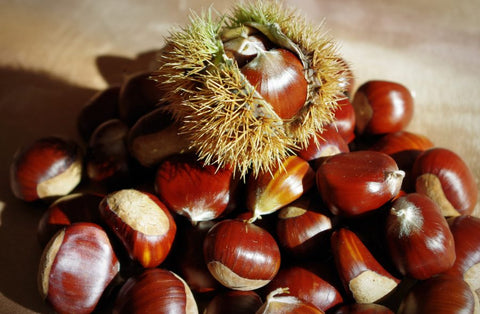Sweet Chestnut Tree Facts and Information
- Latin name: Castanea sativa
- Native words: none
- Ogham sign: n/a
- Height when mature: 30m
- Height after 10 years:
Sweet Chestnut Botanical Description
Sweet Chestnut is a very distinctive tree, hard to mistake! Its leaves are large and spear-shaped with saw-toothed edges. The outer twigs are angular and five-sided with noticeable breathing pores.
Not flowering until July, both male and female catkins grow together. The well-known fruit develops inside a four-lobed bristled casing which falls, splits open, and reveals up to three oval nuts. These typically feature a tuft at the tip, a remnant of the flower’s stigma.
The bark of mature Sweet Chestnuts is striking — young trees have smooth brown bark which soon develops deep spiral fissures. These trees can become enormous; one example in Tortworth, near Bristol, measured 50 feet in girth.
Natural History and Ancient Wisdom of Sweet Chestnut Trees
Originally introduced by the Romans from southern Europe, Sweet Chestnut is now mostly found near grand houses and parks. In medieval times, it was valued for its nuts, and chestnut plantations were established — one was recorded in the Forest of Dean (Gloucestershire) in 1170.
A 1769 survey in Kent noted ancient coppiced and pollarded chestnuts. Poles grown from coppicing are still used to make chestnut paling fences, which command high prices. In 1956, around 50,000 acres of chestnut coppice existed in Kent, Surrey, Sussex, and Hampshire. Long poles also supported hop frames in Kent.
Although we associate roasted chestnuts with British winters, most sold are imported — British trees rarely produce fruit of sufficient quality. Birds and mammals, including mice, squirrels, wild boars, and deer, all enjoy the seeds.
Sweet Chestnut Place Names
Despite not being native, Sweet Chestnut arrived before many English place names were formed. A few examples include:
- Chesteyns (Essex)

Sweet Chestnut Wildlife Rating
The seeds are enjoyed by many animals including birds, mice, squirrels, wild boars, and deer.
The tree's fragrant spring and summer flowers attract a wide variety of pollinators.
Sweet Chestnut Trees Good Points
- A magnificent and noble tree suitable for very large gardens, grand driveways, or wide avenues.
Sweet Chestnut Trees Bad Points
- Mature trees drop many large, bristled seed pods that cover the ground.
Want to Buy a Sweet Chestnut Tree?
For over 20 years, Tree2mydoor has specialised in delivering tree gifts across the UK and Ireland. Our Ancient Wisdom Tree range offers a diverse selection of native saplings, each with a rich history and unique symbolism. These trees make thoughtful, long-lasting gifts for all occasions.